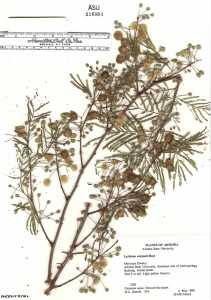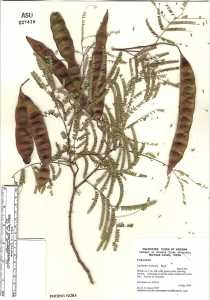Common Name: littleleaf false tamarind
Duration: Perennial
Nativity: Native
Lifeform: Tree
Wetland Status: FACU
General: Large, spreading shrub 5-15 m, with dark brown bark, and numerous feathery leaves, with many pinnae and numerous pairs of leaflets, densely pilose to pubescent to glabrous.
Leaves: On petioles 1-2 cm long with a conical gland 1-2.5 mm high just below lower pair of pinnae, with 4-8 pairs of pinnae, 15-45 pairs of leaflets total, these oblong, 4-10 mm long, 2-4.5 mm wide, puberulent on both sides, spreading and whitish hairs, apiculate at apex.
Flowers: White, ball-shaped, staminate flowers on peduncles 2.5-4.5 cm long, flowers pale cream corolla lobes 3-4 mm long, lance-oblong, the calyces about 2 mm long, puberulent near tips of ovate-triangular teeth.
Fruits: Very large, flat pods, somewhat constricted between the seeds, 1.5-2.5 cm wide and 12-22 cm long, dark reddish brown, glabrous to slightly glaucous.
Ecology: Found on gravelly and rocky slopes and canyon walls, from 2,500-4,000 ft (762-1219 m); flowers May-June.
Notes: Distinctive because of its often low growing spreading habit along with the feathery appearance of the pinnate leaves. Once you are attuned to looking for the greenish feathery quality, along with its being unarmed, this species is more easily distinguished from other legumes.
Ethnobotany: Unknown
Etymology: Lysiloma comes from the Greek lysis for loosening and loma for edge or fringe, while watsonii is likely named for Sereno Watson (1826-1892) an assistant to Asa Gray.
Synonyms: Lysiloma microphyllum var. thornberi, Linnaeus thornberi
Editor: LCrumbacher and Steve Buckley, 2011






